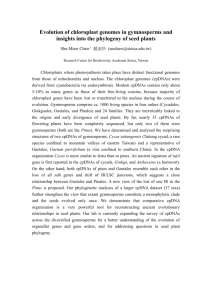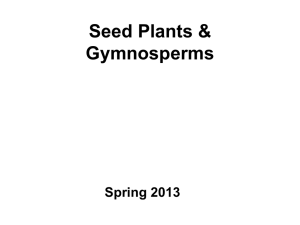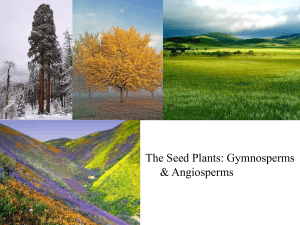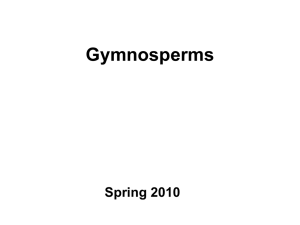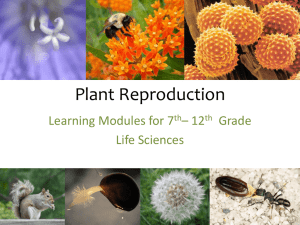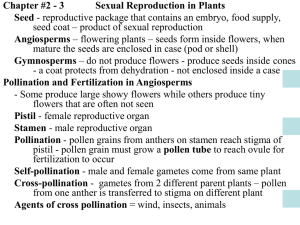Gymnosperms
advertisement
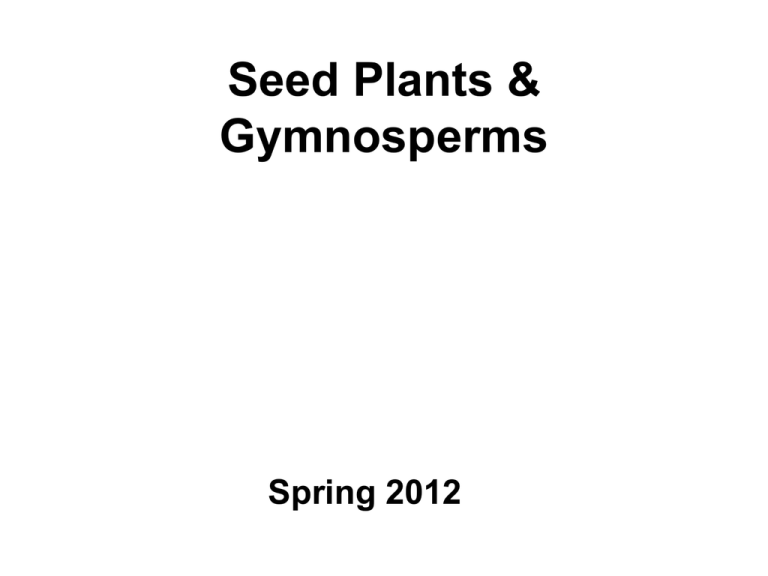
Seed Plants & Gymnosperms Spring 2012 Outline • Review of land plant phylogeny • Characters of seed plants • Gymnosperm phylogeny & diversity – Cycads – Gingko – Conifers – Gnetophytes Review of land plant phylogeny Green plants (viridophytes) Land plants (embryophytes) Vascular plants (tracheophytes) Seed plants (spermatophytes) Gymnosperms Angiosperms Fig. 5.1 Evolution of wood before the evolution of seeds. Fossil lignophytes Progymnosperm (wood, no seeds) Seed fern (wood, seeds) Seed fern fossils from Pella, Iowa Fig. 5.1 Evolution of wood (>380 mya) before the evolution of seeds (>360 mya). Characters of seed plants • Eustele (ancestral) • Axillary branching • Wood (ancestral) – Cambia (vascular cambium, cork cambium) • Seed – – – – Heterospory Megaspore reduction/retention Integument/micropyle Nutritive tissue • Male gametophyte – Pollen grain – Pollen tube Characters of seed plants: Eustele eustele = primary stem vasculature comprising a single ring of vascular bundles Characters of seed plants: axillary branching Bud/branch traces Leaf traces Characters of seed plants: cambia cambia: vascular cambium (wood) & cork cambium (periderm) Fig. 5.3 Fig. 5.4 X-section of woody stem Characters of seed plants: seed • Heterospory • Megaspore reduction/retention • Integument/micropyle • Nutritive tissue Life cycle of most seed-free plants •homospory Zygote Multicellular Sporophyte [with sporangia] 2n SYNGAMY alternation of generations MEIOSIS n Gametes [egg + sperm] Spores Multicellular Gametophyte [with gametangia: archegonia + antheridia] Life cycle of seed plants •heterospory Multicellular Sporophyte Zygote 2n alternation of generations SYNGAMY MEIOSIS n microspores egg sperm Male Gametophyte [antheridia] Female Gametophyte [archegonia] megaspores Evolution of the seed Megaspore reduction: -reduction to 1 megaspore Fig. 5.6 #3 reduction to 1 megaspore Evolution of the seed Megaspore retention: -the one megaspore is retained within megasporangium, not released Fig. 5.6 #4 Evolution of the seed Evolution of integument/micropyle from sterile sporophyte tissue Fig. 5.6 #5 Evolution of the seed •pollination droplet: -secreted by young ovule through micropyle -water + sugars, amino acids (megasporangium) -adhering pollen grains pulled inside! Fig. 5.10 Evolution of the seed -nutritive tissue from the female gametophyte -integument becomes the seed coat Fig. 5.10 Characters of seed plants male gametophyte •pollen grain = extremely reduced male gametophyte, a few cells •pollen tube – formed by the pollen, grows though sporophytic tissue to deliver sperm cells to egg (in ovule) Pine pollen Characters of seed plants: seed Adaptive advantages of the seed: •protection (seed coat) •dispersal unit of sexual reproduction •dormancy mechanisms •nutritive tissue – provides energy for young seedling, aiding in establishment Two major groups of seed plants: • Gymnosperms—not sure of the early evolutionary history of gymnosperms; could be monophyletic or could be paraphyletic • Angiosperms—monophyly supported by many characters including the carpel Gymnosperm Phylogeny Cycads Gingko Pines Gnetales Cypresses et al. pollen tube cones (strobili) simple leaves 1° DNA data Gymnosperm diversity -ca. 15 families, 75-80 genera, ca. 1,000 species -4 or 5 main lineages -all woody -mostly without effective vegetative reproduction -only tracheids in the xylem (except for gnetophytes, which also have vessels) -naked seeds -relatively slow sexual reproduction -worldwide but dominant in many colder or arctic regions -include the tallest, the most massive, and the longest living individual plants Gymnosperm wood: tracheids only Major groups of gymnosperms • Cycads • Gingko • Conifers • Gnetophytes Major groups of gymnosperms Cycadophyta – Cycads •squat, unbranched trunk (little wood), usually pinnately compound leaves •loss of axillary branching •dioecious: male and female plants •male and female strobili (cones) •motile, multiflagellate sperm! (ancestral) •coralloid roots with nitrogen-fixing cyanobacteria Zamia female strobilus Cycas male strobilus Major groups of gymnosperms Cycadophyta – Cycads •ca. 11 genera (130 spp.) •now restricted distribution •seeds with bright fleshy seed coat--dispersed by plant-eating dinos! A native U.S. cycad: Zamia floridana Gymnosperm Phylogeny Cycads Gingko Pines Gnetales Cypresses et al. pollen tube cones (strobili) simple leaves 1° DNA data Major groups of gymnosperms Ginkgophytes – Ginkgo extensive fossil record but…only 1 living species: Ginkgo biloba! •highly branched tree with well developed wood •deciduous, fan-shaped leaves with dichotomous venation •dioecious: male and female trees -male: “cone” with lateral stalks bearing microsporangia -female: no cone, axis with 2 ovules (outer integument layer fleshy) •motile sperm (ancestral) Major groups of gymnosperms Ginkgophytes – Ginkgo Fig. 5.1 Major groups of gymnosperms Coniferophyta – Conifers •ca. 700 spp. •once dominant worldwide, displaced by angios •shrubs or small trees, highly branched with well developed wood •leaves simple, often needle-like or awl-shaped -pines: in fascicles •non-motile sperm (pollen tube needed) •female (seed-bearing) cones in most •include both traditional conifers but now also the Gnetales (gnetophytes) Major groups of gymnosperms Coniferophyta – Conifers •pollen cone or male cone -microsporangia & modified leaves male •seed cone or female cone -axis with modified leaves (bracts, usually reduced), each subtending seed-bearing scale (modified branch system) -woody or leathery or fleshy female Major groups of gymnosperms Coniferophyta – Conifers •seed cone and pine nuts Stone Pine nuts [w U.S.] Korean pine nuts Evolution of the compound conifer female cone Fig. 5.19 Gymnosperm Phylogeny Cycads Gingko Pines Gnetales Cypresses et al. pollen tube cones (strobili) simple leaves 1° DNA data Pollen usually with 2 appendages Leaves linear to needle-like Resin canals in wood & leaves Pinaceae Winged seeds Ovules 2, inverted Pseudotsuga (Douglas fir) Abies (fir) Picea (spruce) Larix (larch) Pinus (pines) -needles in bundles -cone scales thickened at the tip and often armed with a prickle Gymnosperm Phylogeny Cycads Gingko Pines Gnetales Cypresses et al. pollen tube cones (strobili) simple leaves 1° DNA data Pollen without appendages Leaves scale-like to linear Cone scales fused to bracts Microsporangia 2-10 per microsporophyll & ovules 1-20 per cone scale Cupressaceae Juniperus (juniper) Taxodium (bald cypress) Chamaecyparis Sequoia sempervirens (redwood) Sequoiadendron giganteum (giant sequoia) Taxaceae Ovules solitary, cones lacking Seeds with a fleshy, brightly colored aril Podocarpus Araucariaceae Gymnosperm Phylogeny Cycads Gingko Pines Gnetales Cypresses et al. pollen tube cones (strobili) simple leaves 1° DNA data Major groups of gymnosperms Gnetophytes or Gnetales 3 extant genera: Ephedra (65 spp.); Gnetum (28 spp.); Welwitschia mirabilis related to angiosperms? •recent molecular data: a gymnosperm group defined by many characters, e.g.: -opposite leaves, similar pollen -vessel structure (independent of angiosperms) -nonmotile sperm (independent) -double fertilization (independent of angiosperms) -some with insect pollination Major groups of gymnosperms Gnetophyta - Gnetophytes •Ephedra (65 spp.) -common desert shrub -reduced scale-like leaves Major groups of gymnosperms Gnetophyta – Gnetales •Gnetum (28 spp.) •tropical vines, trees, shrubs with opposite leaves that look like angiosperms! Major groups of gymnosperms Gnetales – Gnetophytes •Welwitschia mirabilis -a strange plant native to deserts of Namibia, sw Africa! -2 big curly leaves!
